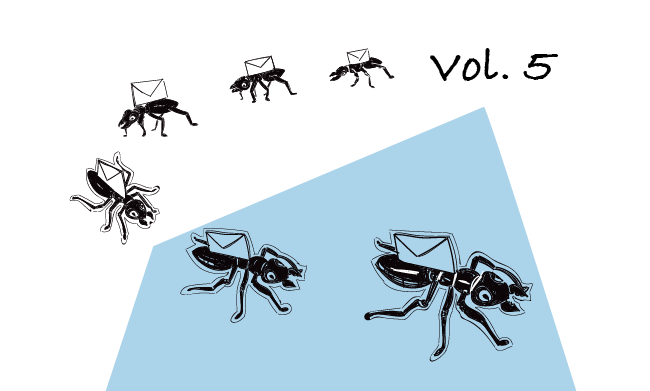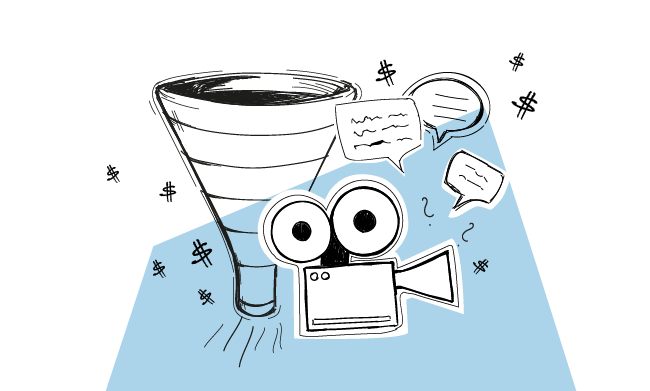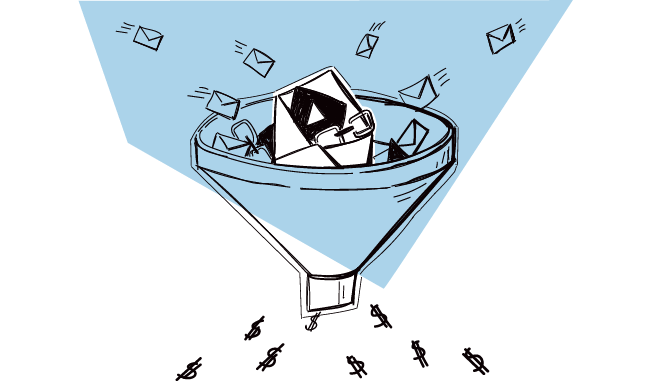You’re probably familiar with the concept of an inbound sales funnel, which is basically the journey your customers take from the moment they hear about your brand to the sign-up.
The funnel is usually divided into three stages. The top of the funnel is the broadest stage that includes anyone who comes across your brand. Yet only the ones who are interested in engaging more with your brand move down the funnel towards conversion.
Your role is to fuel your page visitors’ interest and optimize their journey as much as possible, so the right leads are attracted and nurtured down the funnel until they make a purchase. The concept of a funnel can be copied to your outbound outreach too. Keep reading to find out how to create a cold email sales funnel in Woodpecker in three steps.
STEP #1 Search for prospects who match your ICP
While in the case of an inbound funnel the first stage is about attracting new visitors to your page, in outbound it will be prospecting. You decide who is the best fit for your product and who to reach out to. You act as the first sieve in your sales funnel, by selecting the best matches.
So how to identify those who fit best?
You need to create your Ideal Customer Profile first. Define who would succeed most with your product. What type of user would see the biggest value in it? What industry do they work in? What is their business model? How big is their team? What is their position within the company?
Do a brainstorm session with the rest of your team and try to find the answers to similar questions. Once you do, you’ll have your base ICP and you can start prospecting effectively. However, after some time it’s worth taking another look at your ICP and, perhaps, reworking it a bit.
Here’s how we defined our ICP at Woodpecker:
What Does “Ideal” Really Mean in the Ideal Customer Profile? >>
One way to do it is to take a closer look at your actual customer base and see who your most successful customers are. Which users become customers after a trial period? Or stay with your company the longest?
Analyze your customer data and draw conclusions to revise your ICP if necessary. We’ve been there too. Check out how we approached our ICP review:
How We Actually Rework Our Ideal Customer Profile >>
Now that you know your ICP, you can build a prospect list more effectively with a focus on the right matches.
STEP #2 Create a campaign based on prospect’s engagement
Moving from one stage of the inbound sales funnel to another is based on a lead’s engagement with the content on your website. If they found your blog post helpful, they may want to check out an ebook that goes deeper into the topic. An ebook may direct them to a video explaining how exactly your product solves their problem. If they like it, there’s a chance they will sign up for trial.
In general, the further the person gets in a funnel, the more likely it is that they will convert.
Is it possible to recreate a similar process in outbound sales? Yes. You can build a cold email sales funnel based on a prospect’s interaction with your message, like opening your email a specific number of times or clicking the link in your email copy.
How to do that? You can create a follow-up sequence with a condition that determines the action a prospect has to take to be sent the next follow-up. For example, if a prospect opened your message two or three times, which is a pretty clear sign of interest, they will be sent a pitching follow-up with a link to a landing page. However, If they open the message just once, or not at all, they will be sent another follow-up, with a different copy to increase their engagement.
Check how you can create a condition-based campaign like this:
Introducing If-Campaigns: Send Follow-ups in Response to Recipient’s Action >>
STEP #3 Prepare a dedicated landing page with a personalized video
Those prospects whose interest you caught, now have your full attention. Your goal is to turn their attention into conversion. With a big outbound sales team this is the time for 1-on-1 chat with the potential customer. But if you’re doing your outreach single-handedly or in a small team, a dedicated landing page will help you keep the process personalized, yet automated.
You should have a dedicated landing page for every segment you target with your outbound campaigns. This way you’ll maintain the context and relevance, but also will make your prospects feel unique. And that’s your aim.
How to maintain the right context and relevance? By including a personalized video featuring your sales rep presenting the value of the product for a specific customer group the landing page is tailored to. Base the video on a real-life case that your prospects can relate to. Show them that you understand the challenges they face and have a solution to improve their current processes.
Your video should end with a clear CTA and be accompanied with an option to sign up for trial as this is the final stage of the funnel – the conversion time. The leads who reached this point are very likely to become your customers.
To sum up
Successful outbound sales is all about a 1-on-1 communication. But even when your team is too small to reach out to every prospect personally, you can automate the process without losing a human touch. Personalized follow-ups, dedicated landing page and a use-case-tailored video can help you maintain a 1-on-1 character of your outbound outreach without the need to scale up your team.
Log in to your Woodpecker account or sign up for a free trial to test it for yourself:
FAQ
How does a free trial of cold email marketing software benefit sales teams?
A free trial of cold email marketing software allows sales teams to explore various features like email validation, automated follow-ups, and multi-channel capabilities, ensuring the software aligns with their sales process and outreach strategies.
What makes cold email software essential for effective cold emailing?
Cold email software is essential for effective cold emailing as it offers tools for personalizing email campaigns, managing multiple email accounts, and ensuring email deliverability, which are crucial for maintaining sender reputation and engaging prospects.
Why are cold email campaigns important in a sales engagement platform?
Cold email campaigns are a key component of a sales engagement platform as they enable sales teams to initiate contact with potential clients, leveraging personalized outreach and automated follow-ups to enhance the sales cycle.
How do cold email tools improve the sales process?
Cold email tools improve the sales process by automating repetitive tasks, providing analytics for B testing, and enabling sales teams to send targeted emails efficiently, thus saving time and increasing the effectiveness of sales outreach.
What criteria should be used to select the best cold email software?
When selecting the best cold email software, consider factors like ease of integration with email service providers, the ability to verify email addresses, the extent of customer support offered, and the software’s capacity for handling unlimited email accounts.
How does cold email outreach software differ from general email marketing tools?
Cold email outreach software is specifically tailored for sales teams to conduct targeted, personalized email outreach campaigns, focusing on individual prospects and their pain points, unlike general email marketing tools which are designed for broader audience communication.
What are the advantages of using a dedicated cold email tool?
The advantages of using a dedicated cold email tool include the ability to write personalized emails, track responses in real time, and integrate with sales automation tools, enhancing the efficiency and effectiveness of cold email outreach.
Why is email validation a critical feature in cold emailing software?
Email validation is a critical feature in cold emailing software as it ensures that emails are sent to valid and active addresses, thereby improving email deliverability and protecting the sender’s reputation.
How can sales teams leverage a cold email platform for multi-channel outreach?
Sales teams can leverage a cold email platform for multi-channel outreach by using its capabilities to coordinate email campaigns with other channels like social media or direct calls, ensuring a cohesive approach to prospect engagement.
What are the key components of an effective cold email template?
An effective cold email template should include a compelling subject line, a clear value proposition, a brief mention of the prospect’s company or job title, and a strong call to action, all tailored to address the prospect’s specific pain points.
How does a cold outreach tool facilitate personalized email campaigns?
A cold outreach tool facilitates personalized email campaigns by offering features like mail merge, automated follow-ups, and analytics to track engagement, enabling sales teams to create and execute campaigns that resonate with their target audience.
READ ALSO

5 Tips for Effective Sales Prospecting in 2020
Looking for ideas to level up your prospecting game in 2020? Here you are -- I put together a list of 5 sales prospecting tips worth implementing into your lead generation strategy this year and onwards since I believe they are pretty much everlasting. Get yourself a nice cup of coffee and read on.

The Power of Explainer Video: How to Convert Inbound Leads Into Sales Vol. 5
It's almost a given these days that when a visitor enters a SaaS website, they see a product explainer video embedded into the site. Video explainers are slowly fighting for being on a SaaS web developer's ultimate checklist. It's not unprecedented - I've found some sources supporting the claim that videos increase conversion (here's one of them) or at the very least, the time spent on the site (another study).

How to Create a Webinar Sales Funnel and Boost Webinar ROI?
In search of new ways to boost sales these days, many companies have started hosting webinars. For some, it’s uncharted territory and a new challenge to deal with. Others look for smart ways to scale their existing efforts. No matter if you’re a webinar newbie or you already have some experience in this field, a smooth, efficient, and scalable process should be the foundation of your webinar sales funnel. Let me show you how you can leverage the power of automation to generate and nurture your webinar leads until they try your product.

